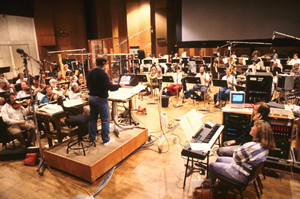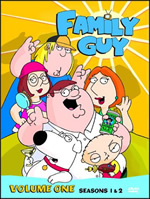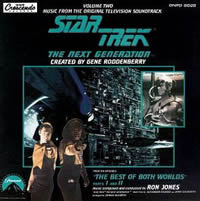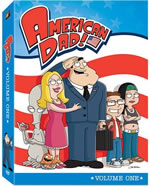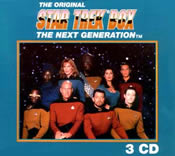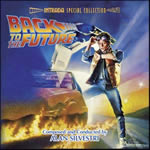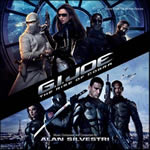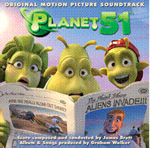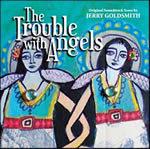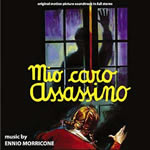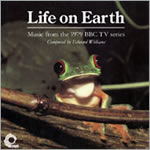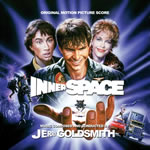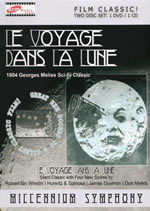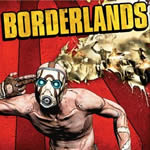 |
Soundtrax: Episode 2009-14
December 1st, 2009By Randall D. Larson
Ron Jones conducts a scoring session for
STAR TREK: THE NEXT GENERATIONFreakin’ Sweet – Ron Jones and the Music for Family Guy
Ron Jones has been a veteran of television music for more than twenty years. Along with composer Dennis McCarthy, Jones defined the episode musical design for Star Trek: The Next Generation in the 1980s. He also scored episodes of the animated show, Duck Tales before becoming associated with Seth McFarland and working on episodes of Family Guy and American Dad since each animated show’s inception. Interviewed last July and updated this week, Jones speaks very candidly about his experiences behind the scenes providing music for Family Guy.
Q: How did you initially start with Family Guy?
Ron Jones: I was working on a couple shows that Seth did for Hanna Barbera. Bodie Chandler was the music director when Seth was at Hanna Barbera, and he had a list of composers, and Seth he said, “oh, Ron Jones, I grew up knowing his music, can I call him?” So I worked on shows like Larry & Steve for Seth - and then he disappeared. Months later, he calls me and says he’s working on a pilot. This was Family Guy. He says “I want you to score the pilot!” And I’m waiting and finally I forgot about it, and then he calls: “Hey, man, I‘m ready for you to do the pilot!” I said, “Oh, cool! When are we going to start?” And he says, “Well, why don’t you come over and we’ll talk about it.” I said, “When does it go?” And he says “Well, tomorrow morning!” He was not kidding me! So I had to compose a theme, input everything myself and mix it – I had to do it all virtual, there was no time to even call a session. I brought it to the dub 40 minutes before the downbeat, and they laid it in and about a week later Fox said, “Yeh, we’re going to buy it.” They had given him a seed grant to work at his kitchen table and develop the show, and that was a year before the series actually launched.
Q: So in this frantic rush to get it done in time, how did you come up with what you needed to do, and is that what stayed throughout the season?
Ron Jones: I had to come with a format. Since I knew what Seth had wanted from these past shows, when I looked at Family Guy, I surmised a bag: since he likes jazz, I’ll put it in that ballpark, but not all of the cues were jazzy. He also likes things that are classic in the sense of how Korngold approached film scoring. The show can be crazy but the music plays against that. It gives the job an extra potency, playing it straight. So that part of it was already in place, but I had a different theme. Later as the show was in production, Seth said that he wanted to submit a main title theme to Fox, which was heavily overseeing everything, in one way or another, since Seth was new to having a whole series. I did about four or five demos – ready-to-go main title options – but he calls me later and says “hey, we chose somebody, we’re going to go with Walter Murphy.” I didn’t know that Walter, who I knew as a friend and we had worked together before, had also been brought into the project by another co-executive producer, David Zuckerman. Seth didn’t know him, but he knew they needed a couple of composers, and they went with Walter’s title theme. Walter had done some of these things that were big hits in the disco era, Beethoven’s 5th and those sort of interpretations, so to Fox, when they ask, what has this guy done, it’s between somebody who has a platinum song, versus me – I’ve done a lot of things for TV but nothing that was a pop hit, so I guess that may also have tipped the scale.
Q: When you’re scoring an episode, one of the first things that comes to mind is that you’ve got to be able to turn on a dime, because there’s so many asides and little fantasy moments, all those things that need a wholly different kind of music. How do you approach scoring an episode when you initially get the script?
Ron Jones: You have to read it and digest it and break it down. Also, when you get the script, the writers are still punching up the story so there are different versions. There’s a first edit version you get, a salmon colored version of the script, and then you get another one that’s a beige one, and finally you get up to one that’s orange. And that one isn’t even locked, so even up to a week before, you think you’ve got it all figured out, and then something changes or a new joke will need a circus cue, or a Superman cue. But I’ll make a breakdown of what is needed. Usually there’s anywhere from ten to thirty different style changes within a single episode, and you have to divide off the polkas and the disco and the dance music or whatever, so you know what band to call. You don’t call the same band every time. It’s like when I scored Star Trek – if it was an emotional story there might be more strings, or more violas or something like that, and on another episode it’s more battle-heavy and you need nine percussion and twelve brass. The same thing is true with Family Guy, at least the way I do it.
Q: What’s the technique as far as you sharing episodes with Walter, do you alternate?
Ron Jones: We alternate. It used to be straight up, we’d go fifty/fifty, but now the writers and Seth have gotten to know what they think are our strong points, so they cast us for each show. It might be that Walter might be two or three shows in a row and I’m sitting out, and then I’ll have two or three, or I’ll done one and he’ll do two and then I’ll do two and he has one. Seth is the one who decides. He’ll go, “well, this is a Walter show, this is a Ron show...” That’s the way it goes.
Q: How closely do you work with Seth or the other producers in establishing the musical tone for Family Guy? How has that developed over the ten seasons?
Ron Jones: When Seth just had one series on his plate, in the first batch before they cancelled the show for a while, it was much more one-on-one. We’d sit and talk about it. Seth is a nano-producer, he’s into every frame. I mean, every frame! So he is the ultimate arbitrator of truth, justice, and the American way on Family Guy. He chooses every aspect. But when we’re spotting, there’s not that much communication. I’m often told, “if Seth wants something he’ll call you.” And then I have to try to grab his attention, and then he calls me while he’s driving to work or something, and I’ll say “yeah, that song with the Nazis, what do you want to do there?” And then I’ll get a little bit of direction. But a lot of times, if he’s really busy now, I’ll just have to go ahead and create something, send him the temp, and he’ll tell me what he likes about it or what he doesn’t like about it. Sometimes I’ll do that and he’ll tell me, “oh, the writers decided to cut that song out…” or “we’re now going to put that in another episode,” so it’s whacky!
Q: Now, aside from the underscore, when there’s a song whether it’s a satire on a Broadway song or a wholly new song, what’s the process of creating that and getting the lyrics done and the voices recorded and all of that?
Ron Jones: It varies. Of course, with animation you have to have everything recorded ahead of time – not only if there’s dancing but any kind of action, because they have to choreograph the animation. So we have to write that for specific voices, we usually create a temp track that they sing to, with a click track for the kind of tempo it’s in. Seth or whoever will sing it, or we will hire singers if it’s really alien to anybody in the cast, and record that. When it comes time for the scoring session, we will then take out those tracks and record the real orchestra or the live players underneath it. It’s like we jack it up, take the tires off, put new tires on, but it’s essentially the same vehicle, and that way we can do it. The lyrics are derived from the script. Occasionally, especially in the first two or three years, it was sort of like Seth would say, I need a song there, and I would write a song, music and lyrics. But now there’s 18 writers on the show and they all believe they can write lyrics, so I don’t get a lot of room to songwrite as much. You have to take what they give you, and then sometimes you’ll say, “this doesn’t work, rhythmically, with music; I’m going to change it to that, what do you think?” and you’ll get their approval. Most of the time it works.
Q: You’ve got one recurring theme, the “return to the house” theme. Are there any other motifs or themes that are re-used throughout the show, and are there any sharing of those between your material and Walter’s material?
Ron Jones: It may sound like there’s a similarity but there isn’t. Though it’s similar I try to write something pretty much new each time. A lot of the music consists of play-ons, coming back in out of commercial or between scenes. You only have a few seconds before the dialog begins, which is not enough time to do a musical phrase. So I said, “Seth, you can’t give us one second before dialog, because you have to be holding and tailing so the dubbing engineer can be doing a diminuendo on the board, so if you cut out of commercial, or you cut to a scene, give us some room to breathe.” I can’t hold right on the dialog. I can be holding maybe at least a half a second early, so you give me 2 and a half or 3 seconds before dialog, it means that I get 2.5 seconds. 2.5 seconds is maybe 5 beats at 120, so it’s not a lot of room to do stuff. I can’t do a musical phrase with only one second before the dialog begins. We try to be as inventive as we can and vary things within the amount of space we have. Most of the time it’s the play-on to the house. The fact is, we’re playing ‘this is an American home’ – it’s a parody of Ozzie And Harriet or Leave It To Beaver, because it’s far more subversive if you have a normal family that wants to blow up the universe than if you have a bunch of crazies. Then it’s not funny anymore. If you play everything crazy, it doesn’t give you any juxtaposition, so I try to stay within that mode while I can. Out of all the cues you spot for Family Guy, probably more than half of them are play-ons. As the story unfolds, say Brian the dog lost his girlfriend or somebody dies, the play-on might change totally. But generally, we come to a moment where it’s sort of like a typical play-on. In fact with my jazz band, which is made up of the core of the guys who do all the recording for the show, we do a typical play-on as a joke during our concerts. I say to the audience, “here’s what we have to typically do and why we’re here tonight, to not do this!’ and then we go [Ron hums a play-on: “diya bot do doo-dahhhhhh”] and everybody just applauds. Here’s a tune that’s like 5 seconds long! I say, “you do about sixty of those and you want to kill yourself!” We have fun with that! In fact they want me to write some more typical play-ons so we have some different ones to play in the jazz concerts!
Q: Now, occasionally, when you’re not totally stuck with 2 or 3 second cues, you have the opportunity to write longer things, such as the music for the recurring fights between Peter and the giant chicken. Is that yours or is that Walter’s music?
Ron Jones: That’s Walter’s. It’s funny, I’ve always thought of myself as the more bombastic composer…
Q: Right, even back on Star Trek, you were the guy who got the big battle scenes….
Ron Jones: Yeah. Even when Walter and I were working with Mike Post and Pete Carpenter, I would always get the big car chase in the third act, and Walter would get the sneaking cue where there was a little high-hat 8th note thing and then a lick for the bad guy. So it may have been when the chicken thing first came on it was one of Walter’s episodes, so once he defined that, that’s where he stayed. Then you’re always the chicken fight guy.
Q: What are some of your favorite and or most challenging moments of Family Guy?
Ron Jones: Every time! I have a piece of paper that says “it’s always hard.” If you in your own mind think, “oh, here’s a light show,” or “here’s a heavy show,” you’re in for a big surprise because there is no such thing. To me it’s like water seeking its own level, even if I have a light show and it has three cues, I would work on that for two weeks. If I had two days to do it, I would do it very quickly. So I use all the time that I have so to me, there is no such thing as a light show or a heavy show. I know that sounds silly, but that’s how it is. I always make it a chance to excel, and I want my next cue to be better than my last one, and that’s what gives me joy when it’s all said and done, is that I put that kind of level of construction into the music.
Q: Family Guy has always used an using orchestra, and you’ve got a fairly large-sized one now, as opposed to having to do what most TV shows do, which is synths or samples. Has that always been the case and how has it developed over the years?
Ron Jones: We’ve evolved. When we first started, even by standards back then, about ten years ago, a 25-26 piece band was our typical band, some woodwinds, brass, rhythm section, some percussion and a few strings. You’d supplement that, if you needed to do a bigger cue, with some samples. And then as we’d get special shows. I’d say or Walter would say, “Hey, to do this Star Wars gag or whatever it is, I can’t do it with this little group, I need a bigger group.” And then we’d to the bigger group and the Seth would notice and we’d get a bigger music budget next year. It’s just slowly evolved, because the shows are always alluding to features. Seth has said, “I think a big component is the music. We mix it like a feature, we do it like a feature, and when people spend 15 bucks on the DVD, they don’t care if it was Batman or a TV show, they want to be rocked by the audio and they want to have it be a really cool experience.” In fact, I was behind putting the show in Surround Sound, because none of the Fox shows were in Surround, and now after we did it, that became the norm. And all we had to do was to set up the configuration of the room that simulated the surround mix. So there’s a stereo mix and there’s a Surround mix.
Q: I was going to ask about that because certainly since the days of Star Trek the audio portion of TV has certainly increased and now you’re getting 5.1 mixes on TV shows.
Ron Jones: Yeah. That’s a standard thing now.
Q: Now is that driven by DVD sales?
Ron Jones: Yes. These mandates come down from on high, on these networks. And then, it’s up to the sound department – not the music department – to start thinking about these things. And then they go, well, geez, the big problem is it must cost a lot of money. And when we priced it out, I called the sound dept at Fox and was very humble, saying, “I’m not calling to tell you what to do, but I think we can do Surround, is that something you want to do?" And he said, “Yeah, I’ve had a mandate sitting on my desk here gathering dust for two years. We just don’t know how to do it.” I said, “Well, what if I check into that and give you specs back.” And he said “Please do.” Our engineer, Armin Steiner, figured it out, and he said, “At best it’s going to cost you five bucks!” “Five bucks?” “Yeah, it’s just a matter of how we lay out the mics and how to spool it off in ProTools.” And they said, “Well, so be it! Let’s do it on all shows.” They sent out a memorandum and said “all shows will now be Surround.” So that’s all it took, but it took somebody from outside to push them. It could just as well have been somebody in the Sound dept.
Q: Has the 5.1 mixing affected your orchestration of the scores?
Ron Jones: Oh, quite a bit. That’s why we’ve evolved the orchestra and the way that it’s mixed. The center of the mix is left open for the dialog to gravitate to, but we’ve been able to really spread out the orchestra to where you really hear the colors. In most TV shows the composer is mixing the music and recording and just throwing stuff into sequence, and they don’t mix them in Surround. They’re mixing in stereo and they’re mixing without regard to the dialog. And so when it goes to the dub they have to use a false means of spreading it out. But it’s too tied to the center, so who’s going to lose? The music loses. The orchestration loses. The colors lose. Whereas if they would know to spread it out, then when it would go up against picture and dialog, it would sit there like it’s supposed to exist, like it’s in a natural spot. But they don’t think like that or nobody ever instructs them in that, and they don’t ask those kinds of questions.
Q: You did the “Stewie Kills Lois/Lois Kills Stewie” episode, which has some wonderful dramatic bits in there, and was very cinematic. What was the challenge for you on that two-part episode?
Ron Jones: They give me these kinds of things, like “Stewie, The Untold Story,” which is a three-parter we did and was released on DVD. “Stewie Kills Lois/Lois Kills Stewie” was supposed to be another DVD but when the Star Wars parody came out, it was such a big hit that Fox at the last minute said “let’s not spool ‘Stewie Kills Lois/Lois Kills Stewie’ into a separate DVD, let’s make the DVD the Star Wars parody.” Eventually they did put “Stewie Kills Lois/Lois Kills Stewie” on DVD anyway. But it was originally supposed to be a big deal, and the writers write it differently, and the length and breadth of the whole idea became much bigger and more feature-like. And when you have six reels to play with rather than three, you can certainly develop your musical ideas. There were all these themes for his world domination and all of that, and they were supposed to tie together. It’s almost a parody on something that you can get at a deeper level, like when he’s going to kill the mother on the cruise ship, they said “can we make this a little bit like Thunderball, a little bit like 007,” and I put a riff in on the guitar and alluded to that kind of genre. And then when he kills her, it was really like an oratorio. I brought in a choir and made it more apocalyptic. It was kind of like Bernard Herrmann with an apocalyptic choir. So I had an oratorio type of sound to emphasize that this is a really important moment, when Stewie, finally goes ahead, after saying how much he wants to destroy his mother, finally blows her away – that was a big moment. It was really like writing opera.
Q: And the way it was animated, with the slo-mo as she’s falling off the boat, which gave the music some room to really be huge.
Ron Jones: They had directed it with all those really cool camera moves and they used all the latest gimmicks that the directors for features are using, and so I was allowed the room to open it up, musically. They do carve out a lot of space when they really want something dramatic. I just did an homage to Korngold for the season finale of Season 6, called “Peters’ Progress.” It wasn’t a copy of Korngold but a kind of a homage to the whole approach, and we recorded it at Warner Bros in the same hall and basically had the same band, size-wise, and really pulled it off. That’s when Seth said, “let’s go with 60 players from now on.”
Q: How did you manage the music on the Star Wars satire, Blue Harvest?
Ron Jones: They actually paid a half a million dollars for the original music. We were not allowed to do an arrangement of the original John Williams score, so they paid for the rights to license the original LSO recording. Then Walter did the little cues that bridge or lead into those John Williams cues. The music editor, Stan Jones, worked his ass off for nine or ten months trying to make that music work. He could slice the John Williams music up in ProTools but we couldn’t re-record it. So Walter’s sessions for those ends up being the play-ons and whatever little numbers that aren’t John Williams score.
Q: What about when there’s a quick flash back to a movie reference and you need a 5-second bit from this movie or that movie – is that always licensed or sometimes do you record your own take on it?
Ron Jones: It’s funny. With Family Guy, though mindful of the budget, especially in these economic times, Seth really believes in the power of the artifact. For instance, on one of the shows they did a joke about this jazzy numbers song that Sesame Street did, and they handed it to me and they asked me to “do one like that.” But as I kept listening and working on it I said, “you know, this is impossible to do as a takedown, because even if we did, we wouldn’t sound like those vocals. We couldn’t get that sound.” It was recorded in a 1960s recording studio somewhere in New York and it had a completely different sound. I could process it, I could do everything, but if they’re really trying to sell the joke – and people’s memories remember the nuances – that sense of noise, that crunch, and that compression – of that original song, and it’s really hard to replicate convincingly. So Family Guy has gotten used to licensing the original music. Even the first show for Season 7 that we just did, there was the Super Friends Main Title. I could have re-recorded it, since we had a better orchestra. But our recording would have sounded like today, and the joke is alluding to what it was. Seth would rather pay to have the real thing to tell that joke, which everybody remembers when they grew up with that, so that’s what they hear. They can even hear the cracks in the band! I told him – I was there at the recording when they did it, because I was working at Hanna Barbera and I remember being there, but I said, “we could do it, no problem, but it’s not going to sound the same.” So he said “Fine, we’ll just pay for it.” They’ll pay for a needle drop.
Q: What did you find different when you were scoring American Dad?
Ron Jones: American Dad doesn’t have the budget, the popularity, or the numbers. They don’t sell the number of DVDs. So when I was doing that, all the way up to the beginning of Season 4, we mirrored Family Guy. Seth had created a template of what he wanted, and we were to allude with the ultra right wing, kind of with the 1941 score kind of sound, and so we’d have these military approaches to the CIA guy who’s always wrong, very patriotic in a right wing sense. We had a pretty good band, but it was always under what Family Guy had. If Family Guy had 50, they’d have 45. We never really got up to their numbers are. Actually, I found I had to do far more of the rhythm section things, the pop songs and country songs and all that. There’s a lot more porn music and a lot of things from strip clubs in American Dad! I’ve probably done more strip club music than anyone! I’m an expert. What do you want, Orange County, you’re looking for something New Jerseyish? I got it! It all has to do with the bass line! And I think I’ve done more rap and hip-hop just on American Dad than JZ! I was doing it before it was even a thing! I remember doing the hip-hop/rap stuff with The Flintstones, which we’d bring in the Fred Flintstone voice, and I wrote this whole rap thing with the spoken lyrics. That was ten years before rap even got on the radio.
Q: How has the concept of writing the music changed, along with the technical approach of getting it recorded over the years?
Ron Jones: The technology is merely at the end of the fulfillment. You have all these new bells and whistles that allow you to record it on a digital disk, but you still have to create music. Technology is a means to the recording of that information. The biggest thing that I have seen is the increase of technology in terms of communications. They can send me a Quick Time movie, I can look at it, score something, and send it back to them to look at. You couldn’t do that before – you’d have to have a meeting and send things through messengers. We used to have messengers at the door two or three times a day taking and delivering scores. Now everything is a PDF file, you scan it in, it goes out to the guy, they put up stuff on my iDisk – that part of it’s really slick. But to tell you the truth, it’s like the Emperor’s New Clothes. ProTools and its plug-ins are the alchemy – beautiful designs and ways of manipulating audio. But it’s still a matter of communicating to the human receptor, and the human receptor has not evolved to the level of our technology. We still have two ears, we listen in stereo, we process information as humans have evolved to this point. So the technology may be a thousand years ahead of where we are as humans than what we can process.
So, musically, I’m still doing the same sort of things. But, say I have to revert to samples where I want to make something sound really pop, we can do it and it sounds pretty convincing, whereas in the past there was noise in the samples and you couldn’t be as accurate. So now, I can write a whole pop tune and send it off to one of my pop guys who will record that and mix it like a record, and it sounds like a flaming record. On earlier shows, that was far more complex – you had to call a session and erect this whole thing. So the power of everybody’s personal computing and personal processing is quite high and elaborate, but the audience hasn’t changed as much. They are still at about the same intellectual level.
Really, it boils down to musical ideas and being able to take those musical ideas and put them in subjection to a story, and tell a story in that context. Certainly we have more means to fulfill that but producers and their budgets will still love to spend a lot of money on casts and spend a lot of money on visual things, but music is the step backward of the whole process – because they know some guy who can just crank out some sort of sound in a processor and give them a file that will give everybody the sense that there’s some musical information going on there, so the show isn’t bone dry, and then that works for them. And if that works then they didn’t have to spend too much money on it, so be it. We have a producer with Family Guy who values the music and adores the great film composers and knows all their work. So he knows what he wants. Seth understands what music can do; he knows to put some sheckles in there. And he actually has this in his contract. Seth came to me when they were in negotiations for the last contract. He brings me into his office and says, “Hey, Ron, what could we put in my contract about the music?” I said, “Put in there that you have to have six violas more each year.” And so whenever the studio bitches and says “oh, you’re calling for a big orchestra!” he’ll say “don’t make me pull out the viola clause! Because then you’re going to be in trouble, because you guys owe us sixteen violas by now!” To my knowledge, Seth is the only producer with that in his contract!
Q: What kind of schedule to you have to see, compose, and record the music for an episode of Family Guy?
Ron Jones: It’s become much more luxurious. There were times where we would spot on a Monday and be scoring on the next Monday, regardless of how much music there was. Since then it’s spaced out and they’ve given us more time. I’m usually given at least ten days, which is really what I need. Let’s say we spot on a Tuesday, late afternoon, to decide where the music is needed in the show. The music editor had to go type up the notes. The picture isn’t even ready to go at the spotting, because they’re still changing it while we’re spotting – they’ll take two seconds out here, or something. So the master isn’t even locked. When the master is locked later that day, they send it over to a post production house to make DVD copies, so then the next morning or afternoon the music editor gets it – so that’s half a day. While I’m waiting for that, I’m collating into categories what’s needed for that episode – if there’s pop songs I need to do, or music in any specific category, I start pulling all the research out of my collections to make sure I understand that bag. I don’t want to have to guess – if I need to write some 1980s pop music or something, I have that done. If it’s music I don’t have, I’ve got to order sheet music or soundtracks or whatever I’m supposed to be copying and have that available. So I have two or three days to get that. Then I start getting notes for the first, second, and third acts, so by about the fourth day in, I’m roaring. I’ve done all my motifs, and then I start writing to the episode. So ten days is a pretty good amount of time to get it done. We’re not like South Park where they turn a whole show over in ten days! I don’t know how they do it. They can be much more current with gags by making fun of something that just was in the news, where Family Guy will have to take a year for a whole show, because they have to record the voices over here and then send it to Korea for the animation. If something major happens in the news, they might redo a scene and animate that, so they can do it if they have to.
In my process, I write a single line sketch, then I do a three-line sketch, and then I do my full version, which I send that out to my team. I have team of seven guys who take the full score and do a virtual version which we lay back to picture in final cut and truncate it, take out all the parts that don’t have music, so Seth is sitting there looking at just the cues, back to back. This is hopefully four or five days before the session, and then I get notes back and either Seth digs it or he says change this, change that. So I make the changes, get those to my guys, they do the final version that goes off to the copyists at JoAnn Kane’s, and then we descend on Fox or Warner Bros or another one of the bigger stages, and record it. That’s the process.
Q: So with that simple schedule, why haven’t you had time to go any other scores?! J
Ron Jones: I am writing all the time for my band and I’m doing orchestra things. I’ve got a couple SyFy Channel things coming up that are going to be interesting. Because Walter and I alternate on scoring Family Guy, I do get chunks of time off where I can go off and do other things. So it allows me the opportunity to do creative things. Doing Family Guy is not creative, it’s constructive. It’s like somebody saying “I want you to put a pool in my back yard and can you do it in ten days?” Well, you can put a pool together but they’re not asking you to create a new kind of swimming pool.
Q: You’re not really creating a new kind of music. The creativity on Family Guy would have been when you first started you and you and Walter were initially defining the musical style of the show.
Ron Jones: Right. Then, on my own time and with my own orchestra I can do whatever I want.
Q: I understand you left Family Guy for a while, but they called you back. Would you explain what happened here?
Ron Jones: Last November [2008], I did call Seth and ask to leave the show. I have a very good friendship with Seth and enjoy working with him. He values music more than possibly any producer in Hollywood ever has. The reason for wanting to quit was sort of complex. I was getting tired of not being challenged. I came here to be the best film composer I can be. I have invested decades into my craft, my art, and believe in my creative abilities. After dealing with the trials of scoring American Dad, those producers fired me even though (according to many) I always turned in a superior score. I was happy not to have to show up for that mess, but it reminded me of why I am in this work. I simply told Seth that I wanted a challenge, not just the same play-ons and stupid stuff. Either give me something that tests my abilities or get someone else. I do film scoring because I love it, not because of money. Seth responded by saying he would give me more challenging work, make the music have a greater role in future shows (we will have 96 players on several upcoming shows) and that he would make sure they would respect and regard my work. So we sort of made a pact to each other as friends. So I am still here and working for the show and things are moving forward in the structure of the new shows with regards to the scores.
Q: When do these SyFy channel assignments come up?
Ron Jones: I just got the script, and one minute it’s going to be one producer and the next it’s going to be another, so it’s supposed to come within the next few months. I don’t know if the working titles will change or not, but it’s two 60-minute science fiction movies that are related. It’s not like part one and part two, but they’re related – same characters, but its two different stories. I think they’re going to film them at the same time. It’s based in a Star Trekking type of universe but it’s not Star Trek.
Q: Do you know if that’s going to let you use orchestra? SyFy has been known for using mostly sample scores…
Ron Jones: We’ve talked about some musical ideas, the producer’s very knowledgeable and probably has a bigger collection of music than I do, which is saying something! So what I’m going to try to do is try to let it grow organically from the story, and then whatever budget allows. Musically, the orchestral palette may change but the musical ideas hopefully won’t. And they’ll be able to fulfill things in a creative way, but I really want to make it grow organically from the story. I’m hoping it will be something like, say you put an 8-track on the bridge of the Enterprise, and it was something the characters wanted to hear, as opposed to inflecting a Mahleresque of Gustav Holst type of score on that time period. When I was working on Star Trek: TNG I had this ongoing question that pissed off a lot of people. I said, look if we’re three hundred years in the future, wouldn’t Jimi Hendrix be classical music? Yeah, we’re kind of held in the bonds of Mahler and Holst and those guys and maybe a little bit of Goldsmith, and that’s as far as we can go, in terms of scales or in terms of colors or electronics. These things would bristle with electronics. Can the style grow out of the huge story? I rubbed ‘em constantly raw with that question, and so when you look back on the canon of what’s been done for Star Trek: TNG if you put my score on and listen to it, and you put somebody else’s score, you can hear someone struggling to write something for their particular situation – they’re on this planet with these guys, and it’s not the same as the last episode where they were a billion light years away with a different situation.
Q: You wanted your scores to allude to the time period and the perspective in which they take place, as opposed to simply providing the perspective of the contemporary audience watching the show.
Ron Jones: That’s right. The crew was far more automated and mechanical. I always treated them as computer oriented, because everything they did was with computers, and then the force they were dealing was more organic orchestra, or it was ethnic, with an ethnic sound for that world. If it were, say, the Romulans or someone, I’d say, “these five notes, that’s their bag. And they chose those five notes because that’s their culture had less oxygen in the air and they had three moons and five suns and they had one eyeball. They might not even have ears,” so their music would be different. I would think about those things, and would at least try to put some sort of difference to paint it with some sort of allusion to those ideas. I would get notes from the writers saying “thank you! I’m not supposed to write you because contractually I’m not supposed to deal with anybody in post-production, but thank you for trying to be true to the script, and I’m glad you found a way to do that.”
One thing I can say about working for Seth is he does appreciate what music does and he does allow us the opportunity to create the best music possible. And it is really different than any other show out here, because of that.
Q: I think that’s one of the things that makes it work so well, you’re not treating it as a cartoon, you’re not writing Carl Stalling, even though the music is incredibly varied, you’re treating these as real people and consequently the humor works better and the characters become more real to the audience.
Ron Jones: That’s right. You asked me the question earlier, do you approach any of these things differently? If I had an easy show or something that’s stupid versus something that’s intelligent, that doesn’t change me at all. In fact I’m the wrong composer to call if you want me to be stupid, because I won’t do it. That’s ultimately what killed me on American Dad. They did not get it, and the show suffers for it. The writers get it, but it’s ultimately these producers who hold the ultimate keys for what ideas come forward or not. So if they’re in charge and they’re off, they’re really off!
But I think we’re creating a new genre of music for animation. Like you said, it’s not Stalling. It’s not that kind of late 20th Century approach. We’re taking off on another tangent, and they are forcing us to create new solutions. It will be interesting to see what it goes, or if in some way they wake up and it fizzles out. I don’t know.
Thanks to Ron Jones for taking the time to discuss his work on Family Guy so candidly with me. For more information on Ron, see his web site at www.ronjonesproductions.com And keep an eye out for a couple of special releases of some of Ron’s best television scoring to appear during the coming year.
Frederik Wiedmann and The Hills Run Red
Frederik Wiedmann graduated from Boston’s Berklee College of Music in 2004 with a Bachelor of Arts in Film Scoring (Suma Cum Laude); he earned the BMI Film Scoring Award the same year, and shortly thereafter began working for composer John Frizzell as an orchestrator, score mixer, arranger, programmer and eventually as co-producer and co-composer. Wiedmann continues to work with Frizzell on upcoming films like Legion and Whiteout while making his own name in film scoring by composing for films like Return to House on Haunted Hill and Cyrus. His latest solo score, The Hills Run Red, has been released on CD by Varese Sarabande, and is a powerful horror-action composition. No, it’s not a remake of Morricone’s splendid 1966 Italian Western film of the same name (aka Un fiume di dollari, This picture has to do with a group of young horror fans who confront the real demented killer from a rare movie, a killer who wears a broken baby doll mask, and who insists his fans pay a gruesome price for their admiration.
The film’s director, Dave Parker, initially told Wiedmann that he didn’t want a traditional horror score for the film, but the composer felt otherwise. “Soon after sharing both our ideas about the music,” said Wiedmann, “Dave and I quickly realized that the right thing for the film is a score on a larger scale, with orchestral elements and electronic layers on top of it. We found that themes are necessary for the story, as well as iconic sounds, that are unique to certain characters.” To accomplish the perfect balance between a more traditional score and the director’s vision, Wiedmann utilized unconventional orchestrations (larger viola section than violins) along with experimental instrumentations (dulcimer, string drums, different woodwinds), performed by the Czech Film Orchestra and featuring vocals by Ayana Haviv on “Desiderio” and the final track “Phantasmagorical Holocaust.”
Wiedmann described, “This final scene in the film needed a grand, operatic, yet horrific and at the same time eerie composition, to really convey the emotions that the main character, Tyler, is going through. Ayana turned out to be a perfect match; her voice has both an ethnic touch as well as an operatic feel. Dave [Parker, director] was a big part of this vocal session and directed the vocalist to the right sound.”
Wiedmann’s score is initially fairly ambient and atmospheric, growing in tonal clusters and progressive layers of orchestration. As the story unfolds and becomes more grisly and horrific, the instrumentation becomes more aggressive, more percussive, harsher, yet maintaining an eloquence even at its most ferocious moments, as in the hint of Haviv’s voice in the opening of “Female Bondage” and the silky, smooth violin and woodwind measures that follow in the same track; while cues like “Director’s Cut,” “Redneck Requiem,” “Lambs to the Slaughter,” and especially the brash “Smoke House” erupt in rhythmic violence and harsh harmonics. Other cues, like and “Highway to Hell” and “On Location” proffer very compelling atmospheres via sustained measures of strings and winds, an alluring tonality that nonetheless retains a distinct sense of menace and apprehension. “Death Martini” caps this anxiety-laden cue with some deep cello chords and a whirlwind of strings that erupt into an assertive chase rhythm, whipped into high gear by pounding percussion and relentless staccato violins. The latter rhythm becomes a kind of pursuit-ostinato for the threat faced by the film fans; it effectively counterpoints the more soothing, melodic flute and vocal harmonies that are associated with the characters. The result is a classic interplay between innocence and malevolence, best exemplified on the album in “The Gorezone” and the climactic “Phantasmagorical Holocaust,” where both elements of the score face off and merge in a dense convolution of musical nuances and motifs that only resolve at their very peak of ascent, echoing off into nothingness. The Hills Run Red is a first rate horror score from a composer worth keeping an ear on.
New Soundtrax in Review
Doug Fake and his team at Intrada have done a marvelous job on providing Alan Silvestri’s epic 1985 sci-fi action score, Back To The Future on CD for the first time. While the second two films in the trilogy received adequate treatment on CD, the original film score, a strikingly powerful and influential composition, has never been released in its original form. The score is a major, large form science fiction score that has been denied a proper release for a quarter century, much to the dismay of many soundtrack aficionados. Two theme/suite cues (about 12 minutes) were included on the film’s songtrack album, released in ’85 by MCA, but they were re-recorded by Silvestri for that album; 8 cues were newly recorded by John Debney, conducting the Royal Scottish National Orchestra, for Varese Sarabande’s 1999 compilation release, The Back To The Future Trilogy. The true magnificence of Silvestri’s original BTTF score is finally fulfilled by this lavish, cheer-worthy 2-disc release from Intrada, which includes the complete original soundtrack music along with a second CD containing alternate early tracks recorded but substantially modified for the final sessions as the film developed and was finalized. The score is completely astounding, a huge, epic symphonic work that came, seemingly, out of nowhere, its composer hitherto associated with small action films like The Doberman Gang, pop-based TV scores like CHiPS, and the light hearted action film, Romancing The Stone, largely scored in a jazz and light-rock idiom. The stunning orchestral breadth and richness of Back To The Future was entirely unexpected; Silvestri was given the opportunity (By Romancing director Robert Zemeckis, with whom Silvestri has maintained an ongoing collaboration ever since) to compose a large-scaled orchestral score, and the composer was more than equal to the task. Silvestri told David Kraft, who wrote about the BTTF recording sessions for CinemaScore #13/14, that “Zemeckis wanted a ‘big’ score and said that since the film didn’t have exotic locations [as did Romancing The Stone] or overly elaborate visuals, the score should give the film large size and scope. Zemeckis also wanted the store to emphasize the time travel aspects of the story and provide an ‘other worldly’ feeling. The film was temp-tracked with Jerry Goldsmith’s First Blood and Bernard Herrmann’s North By Northwest which also indicated to Silvestri the direction the score should take.” Silvestri conducted a 96-piece orchestra, which Kraft pointed out was then one of the largest groups assembled for a film score at the Burbank Studios scoring stage #1 (the recording studio at Universal, the film's distributor, was too small). The score, having waited some 25 years for release, is masterfully presented on Intrada’s release; the alternate cues are fascinating to compare to the final versions, and is a unique glimpse into the work-in-progress stage of what has become a classic film score. Aside from its pervasive main theme, Silvestri captured the nuances of the film, its characters, and its time traveling plot with a score that in many ways was equal to what John Williams was then doing; large form symphonics, sweeping melodic themes, and richly textured musical expressiveness.
Moving from 1985 to 2009, Varese Sarabande has released Silvestri’s mix of orchestra and rock with his score to Stephen Sommer’s large-scale comic book action-fest, G.I. Joe. A suitably muscular score emphasizing large musical histrionics and frequent rock and roll riffing beneath the orchestra, Silvestri’s score is build around a powerful symphonic heroic motif that contrasts well with the rhythm-based rock riff. His writing for the film’s primary action set-pieces (opening convoy attack = “Delivering the Warheads”; Cobra’s attack on the G.I. Joe training facility = “The Pit Battle”; the pursuit through Paris and the fall of the Eiffel Tower = “The JOEs Mobilize”; and the underwater battle beneath the polar ice cap = “Deploy the Sharcs”) is exemplary and orchestrationally fascinating, surging with dissonance, movement, and theme-and-variation. Most of the cues are action-oriented, rhythm-based, but never devolve into dissonance or sonic chaos; Silvestri laces his main motif through them all to build a sense of heroism (as in the eloquent phrasing of the melody in the midst of “Northern Route” and the triumph on “Just About Close Enough”), and the score is effectively colored throughout with as much melodic articulation as it is with rock-based rhythms and raucous action propulsion.
Brian Tyler’s score for The Killing Room, a new limited release from Varese Sarabande Records, is awash with compelling, ambient tonality and parlaying a spellbinding, brooding menace. The film, directed by Jonathan Liebesman, for whom Tyler scored Darkness Falls in 2003 (and who also directed 2006’s The Texas Chainsaw Massacre: The Beginning; scored by Steve Jablonsky), is about a group of people who sign up for a psychological research study and discover they have become subjects of a brutal government program. Using layers of symphonic orchestration – mostly strings over lower intonations of brass and winds, with occasional moaning choral harmonies (“In Memoriam,” “Invocation”) – Tyler has crafted a thoroughly haunting sonic musical design for the film. As deceptively innocuous as the research study taking place in the austere little room of the film’s title, Tyler’s musical atmospheres are alluring and captivating at first listen, but their layers of color, tonality, and gentle rhythm belie the sense of apprehension that they reveal as his sustained sonorities emanate with sonic whispers of malevolent intent. With cue titles like ‘Falling” and “Invocation” and “Subversion” and “Disinformation” and “Agenda” and “Providence,” it is clear the music is doing much more than simply laying down a spooky atmosphere over the top of the story and images; Tyler is molding a psychological perspective in his score, expressively delineating the mindsets of both the characters as they become more deeply immersed in the classified experiment, and of the mysterious research scientists who configure, execute, and manage the grim study. The music almost becomes an element in that same experiment, and the listening audience its test subjects. “In Memoriam,” after its haunting chorale opening, culminates with a marvelous rhythmic progression of revolving violin clusters, traveling continually forward, finally exuding bursts of echoing cello over sustained figures of high violins; a very compelling composition that grows powerfully, if very subtly. There is a splendid, piercing stinger in the second third of “Propaganda” that is marvelously executed and delightfully startling, erupting like liquid shrapnel across the musical spectrum before winding down into a long, slow descent of twisting, sinewy strings and low, howling winds. The choir returns at the second half of “Invocation,” over which Tyler places a few pretty plunks of xylophone (or reverbed harp?) that provide an intriguing color, and again for the 10-minute “Adagio Spiritiso,” a drawn-out variation on the score’s ambience, bridged momentarily by an austere arrangement of rustling piano chords in very high reverb. The Killing Room is a score without themes, without motifs, and yet it sustains a graceful potency through its manipulation of layers of tonality, of harmonic color, of progressive rhythmic sustains, and compelling instrumental flavorings. It’s a moving walkway of musical sound that, once we step on, will carry us irrevocably along to its distant end without stopping or changing velocity, unexpected edges and patterns occasionally rippling the walkway belt, without affecting its unyielding forward motion. “Denouement” is the beginning of the end, the score’s forward motion beginning to slow; a languid descent of strings (a rhythm pattern partly started in “Adagio Spiritiso”), counterpointed by a crosshatched cluster of higher strings, driven by harsh, beaten percussion and low winds. “End” concludes the score with pattern of slow, Sgt. Pepper-ish ascending glissando of full strings (a configuration introduced in “Invocation”) before segueing into a reprise of the cyclical violin figures from “In Memoriam,” which in turn leads us to a final dissolution of the score’s pervasive strings, capped by a single, conclusive piano note.
Richard Marvin rejoins director Jonathan Mostow for the fourth time, after successful collaborations on U-571, Flight of Black Angel, and Breakdown, with his alluring score for Surrogates, a new science fiction thriller starring Bruce Willis. Marvin was a top studio pianist playing for composers like Maurice Jarre, Jerry Goldsmith, and John Williams. In the 1980s, he worked with Mike Post who gave Marvin the opportunity to compose for The A-Team and Hardcastle & McCormick. Marvin’s television work also includes Six Feet Under, In Treatment, Without A Trace, and the new series Three Rivers. Surrogates describes a near future where humans live in isolation and only interact through robotic bodies that serve as surrogates; when several humans are murdered after their surrogates are destroyed, a cop (Willis) investigates the crimes through his own surrogate. For his score, Marvin incorporated over 120 musicians, along with electronic elements, to create an epic dramatic score. He said that his greatest challenge composing this score was maintaining the human emotion and isolation portrayed in the film. Released on CD and download by Lakeshore Records, the hybrid score is indeed a potent one. It is largely built around a driving, percussive riff – this includes using the familiar fast-paced string figures that have become a staple of action scores over the last few years; but Marvin makes effective use of this technique, building on top of it a ponderous and potent slow melody for brass (this is especially evocative in “Shift Enter”), provocative voicings (“Title Sequence”), and a very appealing primary melody, introduced initially in “Drive To Club,” where it soars majestically above the pulsing rhythm below. The riff is present in nearly every cue – supplanted only in “Cam’s Apt./Greer’s Apt.,” “Prophet Lies/Greer Rides,” and “I Want You,” where a lower sonority of synths and strings builds an introspective, character motif. The action material really energizes sequences like “Warrant Received/Foot Chase” and the film’s climax.
A new contender for animated feature films has appeared to rival the Dreamworks/Pixar lock on CGI animated adventures. The newcomer is Madrid, Spain-based Ilion Animation, and their first release, Planet 51, is very much in the style of the Dreamworks/Pixar films – and is a marvelous tale of an invasion from outer space – of an extra-terrestrial planet, where an American astronaut on an exploratory mission happens to be the presumed invader – kind of a reverse E.T. as some have described it. The film is a great entertainment, mixing sight gags, a myriad of cultural references, and a dash of sentimentality, beautifully animated. The musical score by James Seymour Brett, has been released by Decca, although only as part of a 12-track songtrack album; a 7-minute score suite occupies the final track. The balance consists of the 60s and 70s pop tunes that were needle-dropped into the film as part of its reverse-earth cultural satire. Brett’s score emphasizes the emotion and the drama very effectively; this is his second feature score after the 2008 horror thriller, Outpost; Brett previously provided additional music on films such as Alien vs Predator, Ella Enchanted, and The Iron Giant; serving as conductor/orchestrator on scores for 10,000 B.C. and 2012; and conducting the choir on Steve Jablonsky’s first Transformers score. This experience on large-scale fantasy and sci-fi films has served him well; his Planet 51 score rings true and provides the chops needed to bring Planet Fifty One to its effervescent and affecting life. The score suite runs the course of the score’s major elements, albeit in brief form. I’m sure there was a lot more than seven minutes of orchestral music in the film, but that 7:19 will have to suffice for now.
Harkit Records has released Jerry Goldsmith’s lively 1966 score to The Trouble With Angels. Previously available on CD in a pairing with Goldsmith’s Stagecoach score, Harkit has put together a remastered package containing containing the 12-track Trouble soundtrack and a thorough set of notes detailing the music and the film by CinemaRetro soundtrack editor Darren Alison. The score was one of those I treasured back in the early ‘70s when I first got into soundtrack collecting, and barely a handful of Goldsmith soundtracks were issued. The Mainstream LP of this score was one of my first encounters with Jerry’s music, and for all its mid 60’s pop verve, it was and remains a captivating score. The comedy film is about two high-spirited students at a Catholic Girl’s Academy who give the nuns a run for their money; Goldsmith’s music emphasized the youthful spirit of the two girls as well as the breezy spirit of innocent fun and adventure embodied by the film. The main theme, a rollicking pop tune featuring bells, xylophone, dainty flutes, and even steam organ, rattle, and and ooga-horn, is a bubbling, joyful melody; it is followed in the Main Titles by a modern tune with a rock beat, and offset by a beautiful and honest melody featuring some of the finest early string writing of Goldsmith’s career. All of these elements are combined, offset, and integrated throughout the score, which proffers a dizzying change of direction several times in each cue. It’s fun, sparkling, and heart-warming from one of Jerry’s most versatile and prolific periods.
Digitmovies of Italy has issued the complete stereo score by Ennio Morricone’s from Tonino Valerii’s 1972 giallo thriller, Mio Caro Assassino (My Dear Assassin). The score was previously issued only in a 7-track version, coupled with the same composer’s Le Mani Sporche on Italian CD in the early 1990s, Digitmovies has culled almost half a dozen previously unissued tracks from the vaults. Most of the new tracks are alternate versions of the primary themes issued previously, but it’s in these variations that Morricone’s score shines, as the themes are taken through various instrumental and tempi nuances. The primary motifs include an eerie solo vocal by Edda Dell’Orso, here assuming a childlike timbre in her singing, embellished by dissonant celesta, strings, harp, and some minor electronic effects. The latter are especially prevalent in the murder scenes, where they provide a disturbing off-white noise over which meandering notes from harp, eerie strings, electric guitar, and organ roam with menacing intent. A rhythmic love theme for celesta, harp, and strings serves as a suitable respite from the creepy music from the more suspenseful scenes. It’s a very intriguing score on many levels; Morricone’s mastery of expression and mood are well served in this score. Version 3 of “Il Buio Tanta Paura,” the main murder music, is especially eerie with its highly reverbed harp, organ tones, and celesta; the variation on the love theme, “Sogno Interrado,” is slow and slinky.
Soundtrack NewsShawn Clement reports that he has been signed to score Sinbad: The Fifth Voyage, a lavish new live-action fantasy epic due out next year.
MovieScore Media has announced that on December 8th they will release the huge orchestral score from Under the Mountain (starring Sam Neill), composed by the very talented New Zealand composer Victoria Kelly.
Trunk Records has released the first ever commercial soundtrack to Life On Earth, the groundbreaking 1979 BBC TV series that was presented by David Attenborough, featuring music by Edward Williams.
Three of the newly-recorded Michael Nyman film scores issued by his own label, MNR, have been packaged for distribution by Naxos. The 3-CD boxed set includes the individually-released CDs to The Piano, The Libertine, and Greenaway Revisited.
Lakeshore has released a songtrack album from the third season of the Showtime series, Californication, featuring a baker’s dozen songs culled from albums by Rod Zombie, Widespread Panic (a terrific cover of Warren Zevon’s “Werewolves of London” off of their live Driving Songs Vol 2 compilation), Stuffy Shmitt, and others.
Varese Sarabande will release Rupert Gregson-William’s score for the remake of television’s The Prisoner, on December 22th. Javier Navarette’s score for Cracks is now available as a digital download.
La-La Land Records has announced their release of Jerry Goldsmith’s complete score for InnerSpace (1987), previously issued only via five tracks on a song-heavy release from Geffen Records. The label has also announced the complete score, fully remixed, of James Horner’s The Fugitive, and the premiere release in any form of Les Baxter’s marvelous jazz-based score for Roger Corman’s post-apocalyptic drama, Panic in Year Zero.
The revived Music from the Movies web site is now up and running, featuring new interviews with Dario Marianelli, Clinton Shorter, A.R. Rahman, and many new soundtrack reviews. Eventually I am told the archives of the old MFTM site will be posted here as well. www.musicfromthemovies.com
Film Music on DVD
ERM Media have released a marvelous restored version of Georges Melies’ innovative and influential 1904 science fiction classic, Le Voyage Dans La Lune (A Trip to the Moon), presenting the 14-minute film four times, each with a different, specially recorded musical score (an original score was believed to have been specially composed for the film in 1904, but by whom and other details have evidently been lost to time). Robert Ian Winstin provides a solo piano score in the honky-tonk, traditional silent movie vein, which riffs a little too much on the overly familiar and rather clichéd staple of horror scores, the Dies Irae. Louie Hurwitz & Marie Spinosa provide a score that opens with piano in more of a concerto arrangement and then uses solo organ for the introductory classroom scene. A raucous celebratory arrangement of organ, piano, and drumkit serves to accompany scenes of the pre-launch and the exploring the moon cave scene; a folksy accordion and piano escort the rocket through space to its splattery landing on the moon as well as the subsequent sleeping on the craters sequence, while a rock vocal is added to the moon-launch and return to earth moments; it’s all rhythm and vibe with little dramatic interaction with any of the visuals outside of some sound effects added into the musical mix. James Guymon provides a lavish orchestral score that opens with a grand, Gothic, almost Herrmannesque flavoring; moving into winds and woodblock for the classroom, chanting, rhythmic voices for the construction of the moon rocket, pizzicato strings and flutes as well as snare-driven orchestral measures for the pre-launch; a proud, brassy melody for the launch and voyage; mysterioso strings and eerie harp glissando over sustained strings for the sleep, snowfall, and trek through the cave scene; and an energetic wind and strings arrangement, driven by light percussion, for the confrontation with the moon men and escape from the lunar surface; with a small choral motif for the return to earth, capped with the same dark chords that opened the score (and it’s too bad they didn’t continue throughout). Don Myers provides a score comprised of quirky, Parisian accordion melodies, and manages to mickey-mouse the splat-landing on the man-in-the-moon before opening into patriotic La Marseillaise for the arrival on the lunar surface. None of the scores are especially provocative, although Guymon’s comes closest to what was really happening in film music at the time Melies’ made the film. The package includes the DVD containing all four versions of the film, as well as a CD containing each of the scores.
Games Music News
Award-winning composer Jesper Kyd has created an epic soundtrack for Assassin's Creed II, the sequel to the fastest-selling new IP in video game history. Following his atmospheric score for the original Assassin's Creed, Kyd takes the music in an adventurous new direction and crafts an immensely diverse, melodic and progressive musical palette featuring acoustic and symphonic orchestrations with emotional depth and diversity. The original score was recorded with A-List musicians and a Hollywood orchestra and choir at the world-renowned Capitol Studios. Assassin's Creed II, now available for digital download, tells an epic story of family, vengeance and conspiracy set in the pristine, yet brutal, backdrop of a Renaissance Italy. The music propels the action, captures the allure and mystery of the story and immerses players in the breathtakingly detailed settings. Patrice Desilets, Creative Director at Ubisoft: “Jesper Kyd's score for Assassin's Creed II brings players into the Italian Renaissance by providing a true sense of depth for the poignant moments, while also giving a jolt of adrenaline to the action-packed sequences.”
The soundtrack from the highly acclaimed video game Borderlands, will be released on December 8th by Sumthing Else Music Works. The music is the join work of composers Jesper Kyd, Sascha Dikiciyan, Cris Velasco and Raison Varner; the album also features bonus music tracks by these artists and Tim Larkin. “The Borderlands soundtrack was a tremendous collaborative effort between Cris Velasco and Sascha Dikiciyan, Jesper Kyd and myself,” said Borderlands Audio Director Raison Varner. “From the very beginning we wanted to provide a score to Borderlands that would stand out as unique and fresh. Borderlands spits attitude from the opening scene until the end of the game and we needed to match that energy. I hope that listeners will enjoy the mix of ethnic instrumentation, heavy electronic influences and driving beats that help keep Borderlands in your face all the way through!”
Randall Larson was for many years senior editor for Soundtrack Magazine, publisher of CinemaScore: The Film Music Journal, and a film music columnist for Cinefantastique magazine. A specialist on horror film music, he is the author of Musique Fantastique: A Survey of Film Music from the Fantastic Cinema and Music From the House of Hammer. He now reviews soundtracks for Music from the Movies, Cemetery Dance magazine, and writes for Film Music Magazine and others. For more information, see: www.myspace.com/larsonrdl
Randall can be contacted at soundtraxrdl@aol.com

